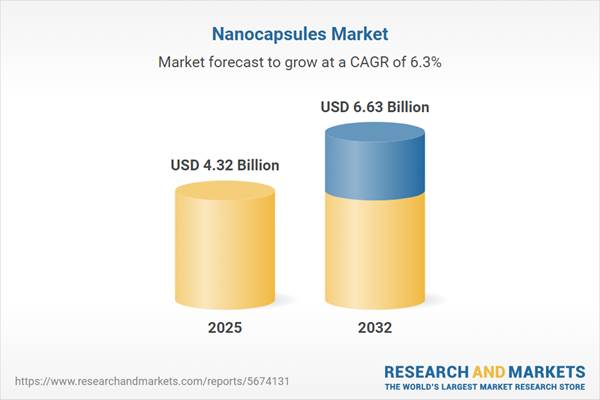Speak directly to the analyst to clarify any post sales queries you may have.
Nanocapsule technology is shaping the landscape for highly regulated sectors, enabling senior executives to drive focused product development, strengthen compliance, and maintain competitive advantage in shifting markets.
Market Snapshot: Nanocapsules Market Size and Growth Trajectory
The global nanocapsules market is on a steady growth path, underpinned by widening adoption in pharmaceuticals, advanced cosmetics, and sustainable agriculture. Established corporations and emerging firms alike are rapidly commercializing nanocapsule-based solutions, leveraging innovation to meet sector-specific requirements. As the market continues to attract new entrants, competition intensifies—fostering more agile business models, strategic technology alliances, and operational enhancements to secure differentiation in a complex environment.
Scope & Segmentation of the Nanocapsules Market
This report provides a comprehensive segmentation designed to support senior-level planning, regulatory alignment, and technical innovation across the nanocapsule sector:
- Material Types: Covers inorganic nanoparticles, lipid-based carriers, natural polymers, and synthetic polymers, focusing on their capacity for controlled delivery systems and consideration of compliance in key domains.
- Core Materials: Examines the use of pharmaceutical actives, cosmetic actives, imaging dyes, essential oils, flavors, nucleic acids, vitamins, nutraceuticals, agrochemicals, and pesticides, with an emphasis on application specificity and unique compliance drivers.
- Applications: Facilitates assessment of nanocapsule deployment in drug delivery for oncology, vaccines, gene therapy, premium skincare, UV protective cosmetics, controlled nutrient release in agriculture, and integration in biosensors and theranostic platforms.
- Production Scale: Reviews stages from laboratory-scale research to pilot and full-scale commercialization, highlighting transition best practices and the flexibility required for shifting market contexts and regulatory expectations.
- Regional Coverage: Tracks trends and regulatory climate across the Americas (especially the United States, Brazil, Canada), EMEA (including key European, Middle Eastern, and African markets), and Asia-Pacific regions (notably China, India, Japan, Australia), enabling tailored approaches for distinct markets and policy demands.
- Key Companies: Benchmarks leading players such as Evonik Aktiengesellschaft, Lonza Group Ltd., Dow Inc., Croda International Plc, Lubrizol Corporation, AptarGroup, Inc., Bristol-Myers Squibb, and NanoCarrier Co., Ltd., offering context for strategic partnership and competitive analysis.
Key Takeaways for Senior Decision-Makers
- Expanding portfolios to include nanocapsule-enabled innovations allows access to adjacent markets with faster go-to-market timelines and minimized initial outlay.
- Partnering with technology specialists promotes agility and fosters cross-disciplinary expertise, supporting practical adaptation as sector dynamics evolve.
- Synchronizing pharmaceutical, cosmetics, and agricultural initiatives accelerates the release and market adoption of nanocapsule-enabled offerings.
- Leveraging digital tools—including AI and analytics—improves formulation accuracy, shortens development cycles, and aids compliance with demanding product and process requirements.
- Building analytics-driven and diversified supply chains enables organizations to mitigate supply disruptions and respond to regulatory change proactively.
- Consistent monitoring of policy trends enables streamlined market entry while reducing exposure to compliance risk as regulatory frameworks evolve.
Tariff Impact: Navigating the Regulatory and Supply Chain Landscape
Recent tariff changes in the United States affecting nanocapsule feedstocks prompt organizations to reassess sourcing and manufacturing strategies. Adopting regional alternatives and optimizing logistics can bolster supply chain resilience, manage costs, and help sustain regulatory compliance while meeting customer and market requirements.
Methodology & Data Sources
This market analysis leverages insights from direct interviews with sector executives and technical specialists, coupled with a thorough review of scientific, regulatory, and industry-focused literature. This triangulation assures relevance for C-level leadership and reflects up-to-date market realities, empowering executive decision-making.
Why This Report Matters
- Empowers senior leaders to seize nanocapsule-driven growth opportunities across pharmaceuticals, diagnostics, and agriculture with actionable strategies supporting innovation.
- Offers detailed segmentation and regional insights for the development of strategies addressing compliance and successful commercial execution in priority regions.
- Serves as a decision-support tool for executive benchmarking and navigation of change within a complex and evolving industry landscape.
Conclusion
Applying data-backed nanocapsule approaches enables organizations to anticipate regulatory, operational, and market shifts. This positions stakeholders for leadership and prepared adaptation in highly regulated industries.
Additional Product Information:
- Purchase of this report includes 1 year online access with quarterly updates.
- This report can be updated on request. Please contact our Customer Experience team using the Ask a Question widget on our website.
Table of Contents
3. Executive Summary
4. Market Overview
7. Cumulative Impact of Artificial Intelligence 2025
Companies Mentioned
The companies profiled in this Nanocapsules market report include:- Evonik Aktiengesellschaft
- Lonza Group Ltd.
- Dow Inc.
- Croda International PLC
- The Lubrizol Corporation
- AptarGroup, Inc.
- Bristol-Myers Squibb
- NanoCarrier Co., Ltd.
Table Information
| Report Attribute | Details |
|---|---|
| No. of Pages | 198 |
| Published | November 2025 |
| Forecast Period | 2025 - 2032 |
| Estimated Market Value ( USD | $ 4.32 Billion |
| Forecasted Market Value ( USD | $ 6.63 Billion |
| Compound Annual Growth Rate | 6.3% |
| Regions Covered | Global |
| No. of Companies Mentioned | 9 |









